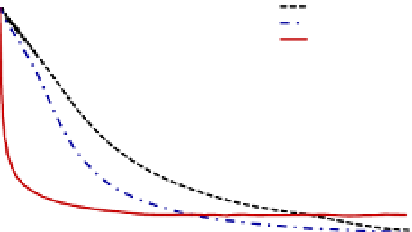Environmental Engineering Reference
In-Depth Information
APGC Synthesis, nZVI Surface Modification and Colloidal Stability
Analysis.
Carboxylic acid-functional APGC containing polyethylene glycol grafts
(PDMS/PEG/AA) were successfully synthesized using the synthesis process described
above. The proton absorption peaks at 0.4-0.5 and 1.4-1.6 ppm in the proton NMR
spectrum correspond to methylene protons created as a result of hydrosilylation of the
vinyl functional precursors to the hydride functional polysiloxane copolymer.
The concentration of nZVI used for determining the effect of polymer-
modification on colloidal stability was based on experimentation. While 10 g nZVI L
-1
would have been the ideal concentration for groundwater remediation (Saleh et al.,
2008), the experiments in this study were conducted with the nZVI concentrations up to
3.0 g L
-1
. Results from sedimentation studies carried out with 0.5, 1.0, and 3.0 g L
-1
bare
nZVI indicated that colloidal stability decreased with an increase in particle
concentration, possibly because of more extensive particle agglomeration. As shown in
Figure 8.5, most of the particles settled out in the initial few minutes of the test. The
authors decided to use an nZVI concentration of 3.0 g L
-1
for further studies.
Sedimentation rates of APGC-modified nZVI were found to vary as a function of
the relative molar concentration of carboxylic acid groups to PEG grafts. Figure 8.6
displays representative data illustrating the effect of APGC composition on the
sedimentation rate of nZVI. It can be seen that modification of nZVI with APGCs
decreases the sedimentation rate, and the APGC with the highest concentration of
carboxylic acid anchoring groups provides the highest colloidal stability.
1.0
Bare nZVI 0.5 g/L
Bare nZVI 1.0 g/L
Bare nZVI 3.0 g/L
0.9
0.8
0.7
0.6
0.5
0.4
0.3
0.2
0.1
0.0
0
20
40
60
80
100
120
Time (min)
Figure 8.5
Sedimentation of bare nZVI in water.





Search WWH ::

Custom Search